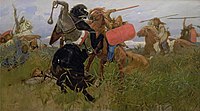Druzhina

| Part of a series on |
| Imperial, royal, noble, gentry and chivalric ranks in Europe |
|---|
 |
In the medieval history of Kievan Rus' and Early Poland, a druzhina, drużyna, or družyna (Slovak and Czech: družina; Polish: drużyna; Russian: дружина, romanized: druzhina; Ukrainian: дружи́на, druzhýna literally a "fellowship") was a retinue in service of a Slavic chieftain, also called knyaz. The name is derived from the Slavic word drug (друг) with the meaning of "companion, friend".[1][2]
 |
| Knyaz (sovereign) |
| Boyar / Szlachta (noble) |
| Druzhinnik (retainer) |
| Smerd (free tenant) |
| Kholop (slave) |
Poland
[edit]Ibrahim ibn Yaqub, who traveled in 961–62 in Central Europe, mentions that the drużyna of Duke Mieszko I of Poland had 3000 men, paid by the duke.[3] Unlike his predecessors, Casimir I the Restorer promoted landed gentry over the drużyna as his base of power.[citation needed]
See also
[edit]- Housecarl
- Leidang
- Hird
- Voluntary People's Druzhina, a civilian organization in the Soviet Union
- Czechoslovak Legion First unit in Russia, called the "Czech Companions" (Česká družina or Družina)
- Wenceslaus I, Duke of Bohemia murdered by Boleslav's companion
References
[edit]- ^ "Online Etymology Dictionary". www.etymonline.com. Retrieved 13 May 2017.
- ^ Zeno. "Drushine". www.zeno.org. Retrieved 13 May 2017.
- ^ "Ibrāhīm ibn Ya‛qūb al-Isrā’īlī al-Ṭurṭūshī," by Lutz Richter-Bernburg, in: The Oxford Companion to World Exploration, David Buisseret, editor-in-chief, 2 vols., Oxford UP 2007, I:402b-403b
Bibliography
[edit]This article incorporates text from a publication now in the public domain: . Brockhaus and Efron Encyclopedic Dictionary (in Russian). 1906.
External links
[edit]![]() Media related to Druzhina at Wikimedia Commons
Media related to Druzhina at Wikimedia Commons

